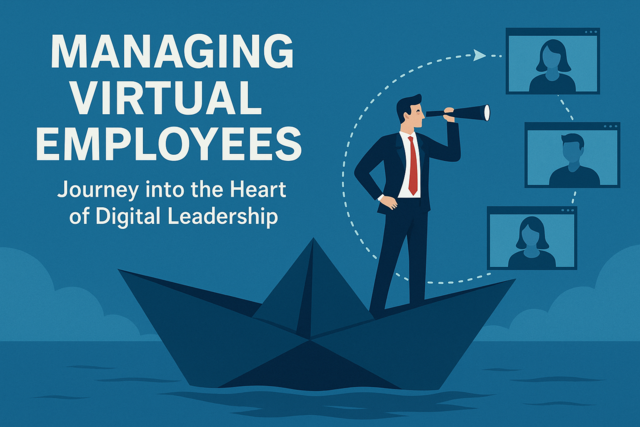Online Class: Managing Difficult Employees

no certificate
with CEU Certificate*
-
15Lessons
-
34Exams &
Assignments -
63Students
have taken this course -
6Hours
average time -
0.6CEUs
Course Description
Mastering the Management of Difficult Employees: A Comprehensive Guide
Every manager, at some point in their career, faces the challenge of working with difficult employees. These individuals exist in every business and industry, and their presence can significantly impact team dynamics and overall productivity. Understanding how to effectively navigate such challenges is crucial for ensuring the success of the team and the organization.
Our meticulously curated course provides an all-inclusive guide for managers, equipping them with actionable strategies and insights to address various challenges posed by difficult employees. From the initial phases of recruitment to potential exit strategies, this course is your ultimate toolkit for effectively managing challenging workplace dynamics.
Course Overview
The contemporary business landscape is ever-evolving. As per recent data, employee-related challenges rank high among managerial concerns, significantly affecting organizational productivity. This course dives deep into:
-
Defining a Difficult Employee: Understand the different facets that categorize an employee as 'difficult' and the impact they can have on team morale and productivity.
-
Pre-Hiring Identification: Learn strategies to spot potential red flags during the hiring process, minimizing the risk of onboarding problematic employees.
-
Onboarding Protocols: Develop effective onboarding processes that cultivate a positive work environment, reducing the chances of negative behaviors from the outset.
-
Effective Communication: Delve into the importance of open dialogue, fostering an environment where problems are addressed head-on and solutions are collaboratively sought.
-
Motivation and Re-engagement: Explore techniques to reignite an employee's passion and drive, transforming negative behaviors into positive outcomes.
-
Managerial Perspective: Learn the importance of adaptability and the role of a manager in ensuring team harmony.
-
Performance Improvement Plans: Understand how to craft and implement effective performance improvement plans that benefit both the employee and the organization.
-
Healthy Workplace Relationships: Grasp the importance of mature, adult-adult interactions in the workplace, and how to avoid falling into negative parent-child dynamics.
-
Human Resources Intervention: Recognize when to escalate issues to HR and the processes involved.
-
Navigating Endings: Understand the complexities involved in parting ways, ensuring the best outcome for all parties involved.
-
Best Practices: A summary of the essential strategies and methodologies for managing difficult employees.
Each lesson in this course is bolstered with real-life case studies, actionable assignments, and rigorous exams to ensure thorough understanding and application of the knowledge gained.
Why This Course?
Navigating the challenges posed by difficult employees requires a blend of empathy, strategic thinking, and actionable insights. This course is designed to provide managers with a holistic understanding of the various aspects involved in managing difficult employees, equipping them with the tools needed to turn potential challenges into opportunities for growth and development.
Whether you're a new manager looking to develop your skills or an experienced leader wanting to enhance your toolkit, this course offers invaluable insights that can be directly applied to your workplace. Dive in and transform your managerial journey today!
- Completely Online
- Self-Paced
- 6 Months to Complete
- 24/7 Availability
- Start Anytime
- PC & Mac Compatible
- Android & iOS Friendly
- Accredited CEUs

Course Lessons
Lesson 1. Challenging Personalities at Work
Difficult employees can strain a manager's ability to maintain a harmonious workplace due to their varied disruptive behaviors, such as playing the victim or indulging in gossip. Understanding the root causes of such behaviors is key to managing these individuals effectively and potentially transforming them into valuable team members.Lesson 2. Workplace Dynamics: Managing Difficult Employees
Difficult employees disrupt workplace harmony, damaging company culture, colleague trust, and business objectives. Addressing these issues early on can prevent a ripple effect where good employees leave due to the toxic influence of a few.Lesson 3. Detecting Red Flags During Hiring
Advanced interview techniques and shadow days can reveal candidates' problematic traits early, allowing companies to set proactive management plans. This approach not only minimizes workplace disruption but also provides a clearer framework for cultivating employee strengths.Lesson 4. Welcoming the Unruly: Onboarding with Strategy and Care
Onboarding is not merely about signing documents but about making employees feel valued and welcome, crucial for their engagement and productivity. Personalized attention during orientation, appropriate training, and constructive follow-up can prevent challenging behaviors and enhance employee satisfaction.Lesson 5. Spotting Red Flags in the Workplace
Managers should be vigilant in noticing signs of unmanageable employees, who might mask their challenging traits during interviews. The lesson underscores using coworker complaints as a tool to identify and rectify problematic behavior promptly.Lesson 6. Problem-Solving by Listening: Tackling Employee Challenges
Frequent organizational changes without clear communication can lead to gossip and reduce trust among employees, thus fostering unmanageable behaviors. Managers must prioritize transparency and employee involvement to maintain stability and confidence in the workplace.Lesson 7. Addressing Problematic Employee Traits Promptly and Effectively
Lesson 7 emphasizes the importance of promptly addressing difficult employee behaviors by identifying them early and implementing corrective solutions before they become habitual. This proactive approach helps maintain workplace harmony and protects organizations from negative impacts on reputation, relationships, and employee morale.Lesson 8. Reviving Workplace Spirit: Strategies to Re-Engage Employees
The lesson emphasizes re-engaging difficult employees by addressing their behaviors, understanding their needs, and fostering an empathetic and communicative workplace culture, which can transform them into valuable assets to the organization. Re-establishing connections through dialogue, empathy, team building, vulnerability, and new responsibilities are key strategies highlighted for reducing problematic behaviors and enhancing employee commitment.Lesson 9. Unlock Their Potential: Personalized Employee Motivation Tactics
Understanding that every employee is unique, managers must adapt motivation strategies to suit individual preferences, whether driven by personal ambition or the need for external rewards. Consistent and meaningful praise, paired with clear growth opportunities, can transform challenging behaviors into constructive workplace contributions.Lesson 10. Root Causes and Solutions: A Manager's Guide
Managers can avert workplace discord by addressing the root causes of unsatisfactory employee behavior, viewing these issues through a broader lens to implement resolution strategies. Ensuring tasks are both challenging and manageable, embracing mistakes as learning steps, and fostering growth opportunities can transform potential problems into avenues for development.Lesson 11. Turning Challenges Into Opportunities: The Power of Performance Plans
When motivation and perspective shifts aren't enough, performance improvement plans serve as a targeted tool to help employees refine their conduct. Key components include setting clear, quantifiable objectives and maintaining comprehensive records of progress through ongoing feedback.Lesson 12. Addressing Behaviors, Not Personalities: A Guide
Approaching employee misconduct with empathy and respect strengthens trust and steers the conversation toward resolution. By addressing issues directly and respectfully, managers create supportive environments that foster change.Lesson 13. Recognizing When It's Time for HR Intervention
Understanding when to involve HR is crucial as difficult employee behaviors like bullying or spreading harmful gossip can create a toxic work environment. Even persistent negative habits resistant to management strategies need HR's guidance to maintain organizational harmony and prevent potential legal repercussions.Lesson 14. Deciding When to Part Ways: Strategically Evaluating Difficult Employee Situations
Lesson 14 underscores the complex challenge for managers in deciding whether to penalize, transfer, or terminate employees based on their behavioral issues. It stresses a tailored approach that considers both organizational integrity and individual employee potential.Lesson 15. Transforming Workplace Challenges into Opportunities
Onboarding programs and orientations set the foundation for new employees by promoting organizational values and reducing challenging behaviors. Effective training and continuous feedback mechanisms, such as 90-day reviews, help employees align with company culture and expectations.
Learning Outcomes
- Define the characteristics of each type of difficult employee in the workplace.
- Identify the root causes that lead to employees being labeled as difficult to manage.
- Describe at least three specific ways in which managing difficult employees can improve workplace environment and overall organizational success.
- Define and identify the impact of each type of difficult employee on company culture, colleague relationships, and business objectives.
- Define specific behavioral indicators during the interview that suggest potential difficulties in employee management.
- Demonstrate the ability to use behavioral-based interview questions to identify traits linked to challenging workplace behavior.
- Define the key components of an effective onboarding process, including orientation, on-the-job training, and new hire follow-up, to ensure new hires integrate successfully into the organization.
- Demonstrate strategies to engage and manage employees with potentially difficult tendencies during the onboarding phase, fostering a positive workplace culture and minimizing potential conflicts.
- Define behaviors and characteristics that indicate red flags for potentially difficult to manage employees.
- Demonstrate the ability to identify red flags through feedback from coworkers and external sources like customers or vendors.
- Identify and implement effective conflict resolution skills to enhance employee engagement and productivity in the workplace.
- Recognize the root causes of challenging employee behavior and demonstrate empathy by developing constructive management strategies.
- Recognize and demonstrate strategies to address difficult employee behaviors swiftly to prevent them from becoming habitual and affecting the workplace.
- Demonstrate mastery of lesson content at levels of 70% or higher.
Additional Course Information

- Document Your Lifelong Learning Achievements
- Earn an Official Certificate Documenting Course Hours and CEUs
- Verify Your Certificate with a Unique Serial Number Online
- View and Share Your Certificate Online or Download/Print as PDF
- Display Your Certificate on Your Resume and Promote Your Achievements Using Social Media

Choose Your Subscription Plan
No Certificate / No CEUs
This course only
| Includes certificate | X |
| Includes CEUs | X |
| Self-paced |

|
| Instructor support |

|
| Time to complete | 6 months |
| No. of courses | 1 course |
Certificate & CEUs
This course only
| Includes certificate |

|
| Includes CEUs |

|
| Self-paced |

|
| Instructor support |

|
| Time to complete | 6 months |
| No. of courses | 1 course |
Certificates & CEUs
Includes all 600+ courses
| Includes certificate |

|
| Includes CEUs |

|
| Self-paced |

|
| Instructor support |

|
| Time to complete | 12 Months |
| No. of courses | 600+ |
Certificates & CEUs
Includes all 600+ courses
| Includes certificate |

|
| Includes CEUs |

|
| Self-paced |

|
| Instructor support |

|
| Time to complete | 24 Months |
| No. of courses | 600+ |
Related Courses
-
 8 hours
0.8 CEUs
Creating a Positive Work Environment
+ More Info
8 hours
0.8 CEUs
Creating a Positive Work Environment
+ More Info
-
 5 hours
0.5 CEUs
Business Etiquette
+ More Info
5 hours
0.5 CEUs
Business Etiquette
+ More Info
-
 7 hours
0.7 CEUs
Lean Management
+ More Info
7 hours
0.7 CEUs
Lean Management
+ More Info
-
 8 hours
0.8 CEUs
Restaurant Management Mastery
+ More Info
8 hours
0.8 CEUs
Restaurant Management Mastery
+ More Info
-
 6 hours
0.6 CEUs
Fair Standards Labor Act and the Workforce
+ More Info
6 hours
0.6 CEUs
Fair Standards Labor Act and the Workforce
+ More Info
-
 4 hours
0.4 CEUs
Launching Your Home Daycare Business
+ More Info
4 hours
0.4 CEUs
Launching Your Home Daycare Business
+ More Info
-
 2 hours
0.2 CEUs
Purchasing and Vendor Management 101
+ More Info
2 hours
0.2 CEUs
Purchasing and Vendor Management 101
+ More Info
-
 7 hours
0.7 CEUs
Organizational Behavior in Business
+ More Info
7 hours
0.7 CEUs
Organizational Behavior in Business
+ More Info
-
 3 hours
0.3 CEUs
Problem Solving Strategies
+ More Info
3 hours
0.3 CEUs
Problem Solving Strategies
+ More Info
-
 8 hours
0.8 CEUs
Strategic Planning
+ More Info
8 hours
0.8 CEUs
Strategic Planning
+ More Info
-
 7 hours
0.7 CEUs
Business Law for Entrepreneurs
+ More Info
7 hours
0.7 CEUs
Business Law for Entrepreneurs
+ More Info
-
 4 hours
0.4 CEUs
Business Budgeting 101: How to Plan, Save, and Manage
+ More Info
4 hours
0.4 CEUs
Business Budgeting 101: How to Plan, Save, and Manage
+ More Info
-
 7 hours
0.7 CEUs
Employment Law Fundamentals
+ More Info
7 hours
0.7 CEUs
Employment Law Fundamentals
+ More Info
-
 5 hours
0.5 CEUs
Running Effective Meetings
+ More Info
5 hours
0.5 CEUs
Running Effective Meetings
+ More Info
-
 5 hours
0.5 CEUs
Recruitment and Retention Strategies
+ More Info
5 hours
0.5 CEUs
Recruitment and Retention Strategies
+ More Info
-
 9 hours
0.9 CEUs
Introduction to Six Sigma
+ More Info
9 hours
0.9 CEUs
Introduction to Six Sigma
+ More Info
-
 5 hours
0.5 CEUs
Operations Management 101
+ More Info
5 hours
0.5 CEUs
Operations Management 101
+ More Info
-
 5 hours
0.5 CEUs
Team Building 101
+ More Info
5 hours
0.5 CEUs
Team Building 101
+ More Info
-
 4 hours
0.4 CEUs
Managing Virtual Employees
+ More Info
4 hours
0.4 CEUs
Managing Virtual Employees
+ More Info
-
 5 hours
0.5 CEUs
Workplace Safety
+ More Info
5 hours
0.5 CEUs
Workplace Safety
+ More Info
-
 10 hours
1.0 CEUs
Disaster Risk Reduction: Preparing for Emergencies
+ More Info
10 hours
1.0 CEUs
Disaster Risk Reduction: Preparing for Emergencies
+ More Info
-
 4 hours
0.4 CEUs
Understanding Workers' Compensation
+ More Info
4 hours
0.4 CEUs
Understanding Workers' Compensation
+ More Info
-
 7 hours
0.7 CEUs
Respectful International Workplace
+ More Info
7 hours
0.7 CEUs
Respectful International Workplace
+ More Info






